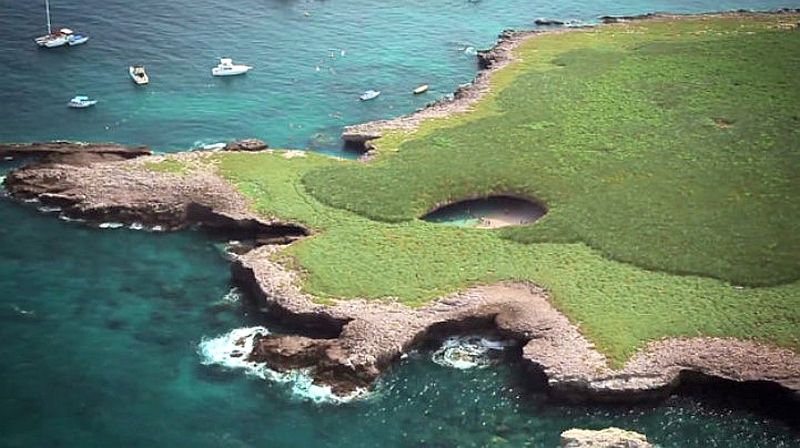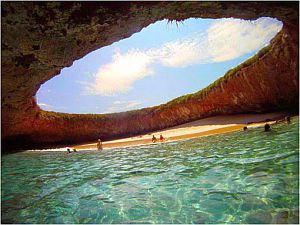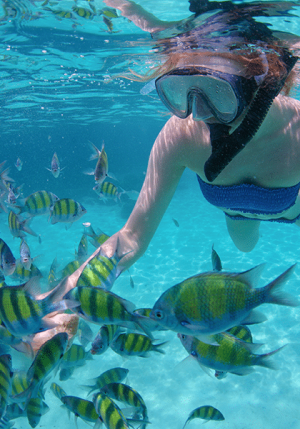
Puerto Vallarta, Mexico – The Marietas Islands, a haven for nature enthusiasts, bask off the coast of Nayarit, Mexico. Often hailed as the “Galapagos of Mexico,” these islands boast a staggering biodiversity, particularly in their avian population. Frigatebirds, pelicans, boobies with blue or yellow feet, and a vibrant tapestry of swallows, all numbering around 80 species, call this island paradise home.
The park’s allure extends far beyond its feathered residents. Among the wildlife that can be seen around the islands are tropical fish, giant manta rays, thornback rays, hammerhead sharks, silky sharks and bull sharks. During the winter, the route to the islands provides the opportunity to enjoy watching the display put on by the humpback whales that visit the Bay of Banderas every year. During the summer, it’s easy to come across one of the thousands of Olive Ridley turtles that lay their eggs on the beaches. Both experiences are truly amazing.

But the crown jewel is a unique geological marvel: the Playa Escondido (Hidden Beach), also known as La Playa del Amor (the Beach of Love). Imagine a hidden cove, accessible only through an underwater tunnel that snakes beneath towering cliffs. The cave’s ceiling has given way, creating a breathtaking hole that allows sunlight to bathe the secluded beach below.
Researchers have debunked fantastical tales spun by some tour guides, revealing the cove’s true origins. The intriguing Hidden Beach owes its existence to the persistent power of erosion. Over time, the relentless waves gnawed away at the rock, creating a spectacular hole in the cave’s ceiling. This secluded beach is only accessible by swimming through an underwater tunnel that connects it to the open ocean. This haven for snorkelers, divers, and birdwatchers is a protected area, ensuring its ecological balance.
The entire Marietas Islands National Park covers roughly 1,400 hectares, with individual island sizes varying. Isla Redonda, the largest, stretches roughly 400 meters long and 200 meters wide. During the late 1960s, in an effort to preserve the environment and prevent harm to the area, marine conservationist Jacques Cousteau stepped in. Bringing much-needed attention to the islands when he began advocating for their protection, his efforts ultimately paid off.

Some 40 years later, in 2005, the islands were finally designated a national park – Parque Nacional Islas Marietas. Offering further protection from destruction, in 2008 they were also designated as a UNESCO MAB (Man and Biosphere) Reserve. MAB sites are those which aim to strengthen the relationship between people and the environment with the help of science.
These protective measures were, however, deemed not enough. By August 2016, there were almost 2,500 tourists visiting daily. Both natural phenomena and bad tourism practices continued to negatively impact the coral colonies in the area. Officials declared the temporary closure of Hidden Beach as they worked evaluate the best way to keep the popular tourist attraction open for the long-term. For the past eight years, access to the Hidden Beach has been strictly regulated to protect the islands’ delicate ecosystem.
The National Commission of Protected Natural Areas, spearheaded by biologist Jorge Castrejón, oversees the park’s management. He, along with tourism operators and local fishermen, has implemented crucial control measures to preserve the bay’s beauty. Through effective collaboration, tourist activities are designed to minimize their impact on these sensitive areas.
Mexico’s Natural Protected Areas, particularly the Marietas Islands, benefit from a vital advisory council. This council, comprised of researchers and organizations, provides invaluable support, ensuring expert knowledge guides conservation efforts.
The park’s success story is evident. The devastating hurricane that struck last year caused significant coral reef mortality. However, thanks to the implemented conservation measures, coral coverage is steadily recovering. This serves as a beacon of hope, demonstrating that human intervention can effectively aid nature’s remarkable ability to heal. The future holds promise: a future where responsible tourism and mindful human actions foster a thriving ecosystem within the Marietas Islands National Park.




